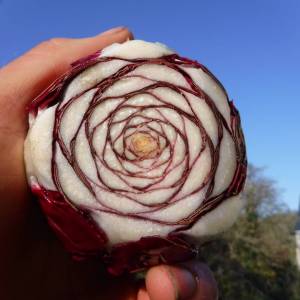Check out the new Trill Farm Garden website which has more updated information about us and what we do…
Tomato seed saving
Plant selection
Select strong healthy plants with characteristics that you are looking for. If it is an heirloom variety that you are saving, it is best to select the variety that best fits the description of the variety. If you want to select varieties that fruit earliest, then select the earliest fruiting each year.
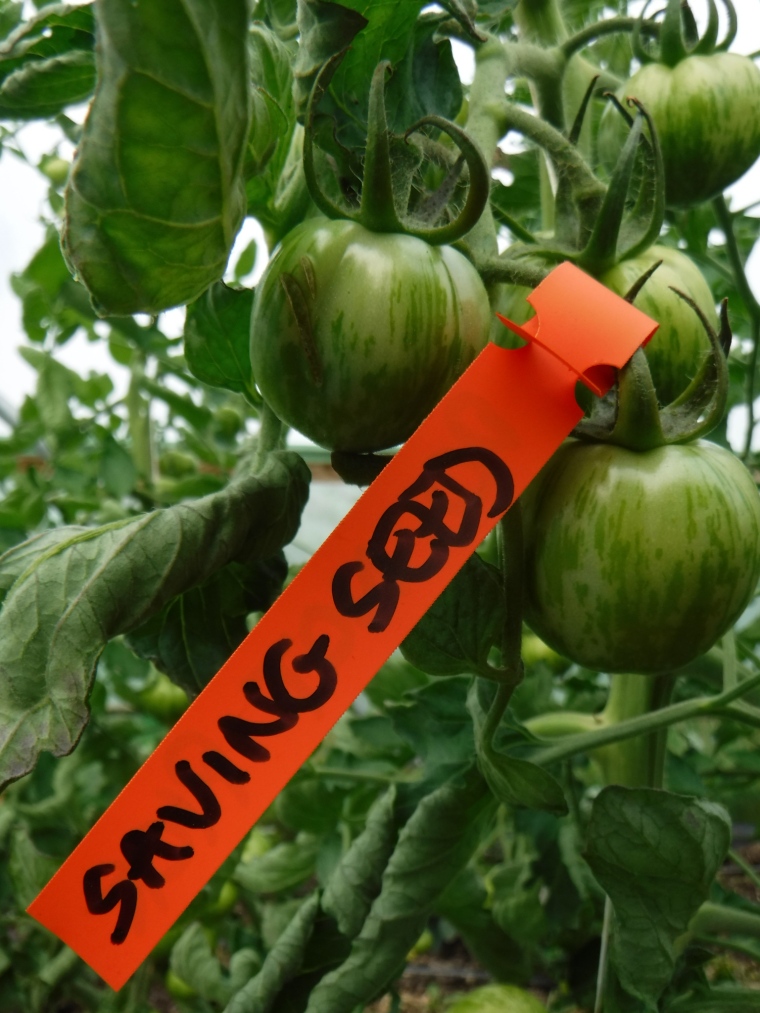
Clearly label the plants that you have selected. Tomato plants generally do not cross with one another (they are in-breeders) so you can grow and save seed from more than one variety in one polytunnel.
Harvest and processing
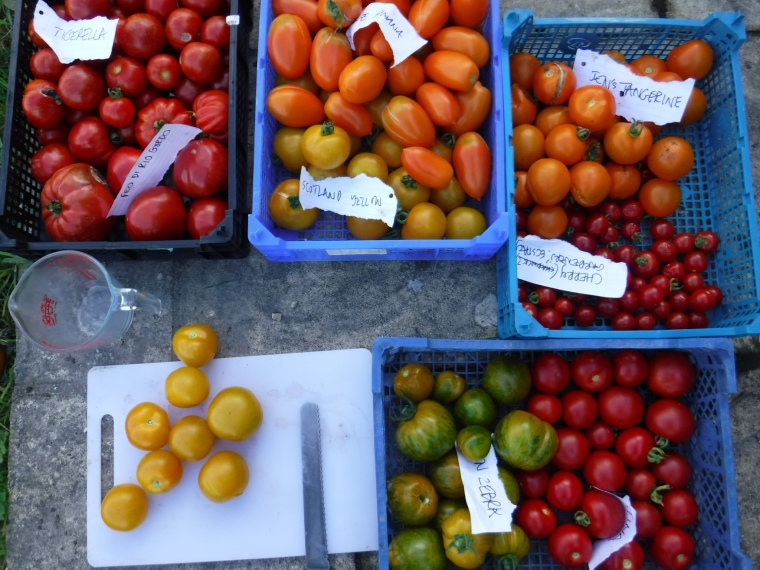
Once the fruit is over-ripe for eating it will be ready for harvesting for seed. At this stage take all the ripe fruit off the plants, then slice them along their equator (use a bread knife for this as it is less likely to damage the seed). Then squeeze out the pulp into a container.
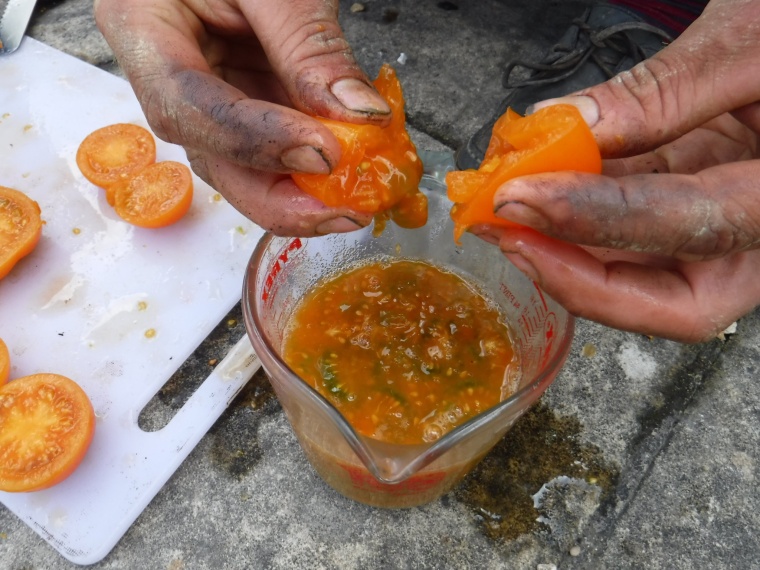
This can then be left for 3-4 days to ferment (this breaks down the germination-inhibitor that surrounds the seed). Do not leave for longer than for days as premature germination can occur. You may notice a mould appearing at the top of the pulp – this is fine and all part of the fermenting process.

Once fermentation is completed then poor the pulp/seed into a long necked container – something like a milk bottle works well. Fill it up to ¾ full and shake the bottle vigorously (with a lid on…). This helps to separate the seed from the pulp. As the seed starts to settle back down to the bottom of the bottle you can start to decant the pulp and water. A few small, light seeds may also come out. Decant until most of the water has left the bottle then repeat this process 5 or 6 times, or until the seed looks clean.
Fill up the bottle, now with clean seeds in, one last time and empty into a sieve. Blot the bottom of the sieve with kitchen towel to dry excess moisture and then turn out the seeds ideally onto a non-stick surface such as a plastic chopping board. Using the bottom of the sieve, spread out the seeds evenly to form one layer of seeds. As you are doing this you can have a bit of kitchen towel inside the sieve which will take away some of the moisture without the seeds sticking to the towel.
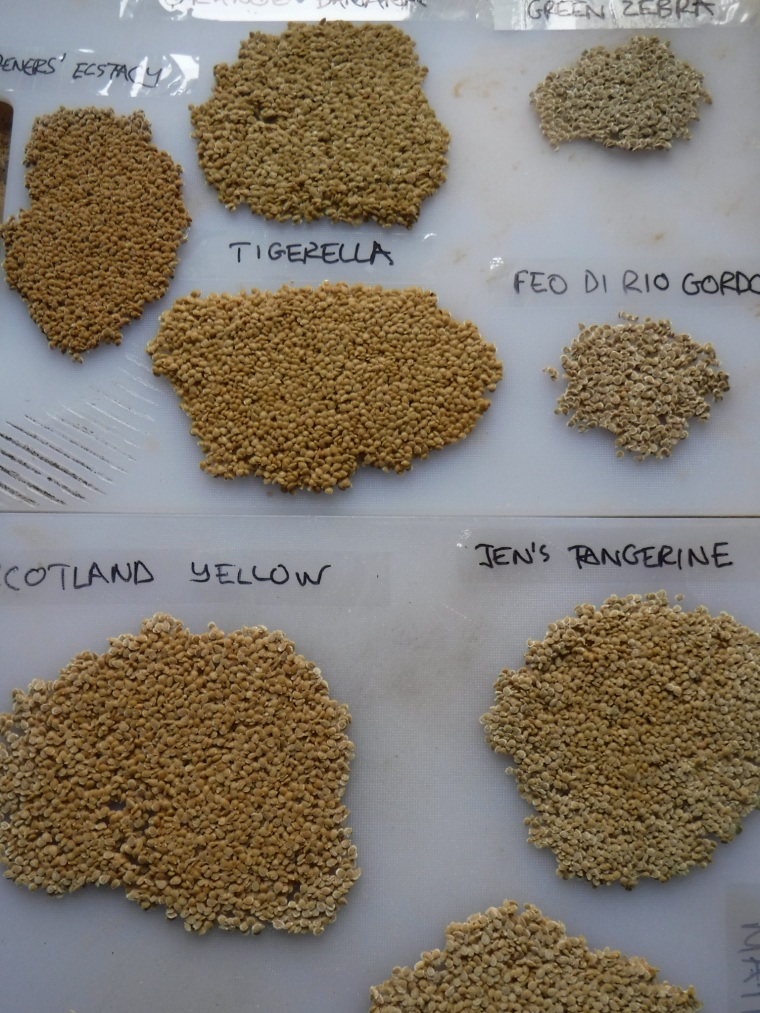
Label the seeds and put somewhere dry and airy to dry further. Once the seeds have dried they will peel off the chopping board in one piece. They can then be crumbled up into a paper seed packet and dried further using silica gel. To do this put the seed packet inside an airtight container and put the same amount of silica gel in the bottom of the container. Put a humidity reader into the container and close the lid. Leave until the relative humidity is around 50%. Then remove the silica gel and store the seeds in the airtight container somewhere cool and dry, and they should keep for up to 5 years. Don’t forget to clearly label the seed packet with the variety and the date.
Slow down, seed saving and squash
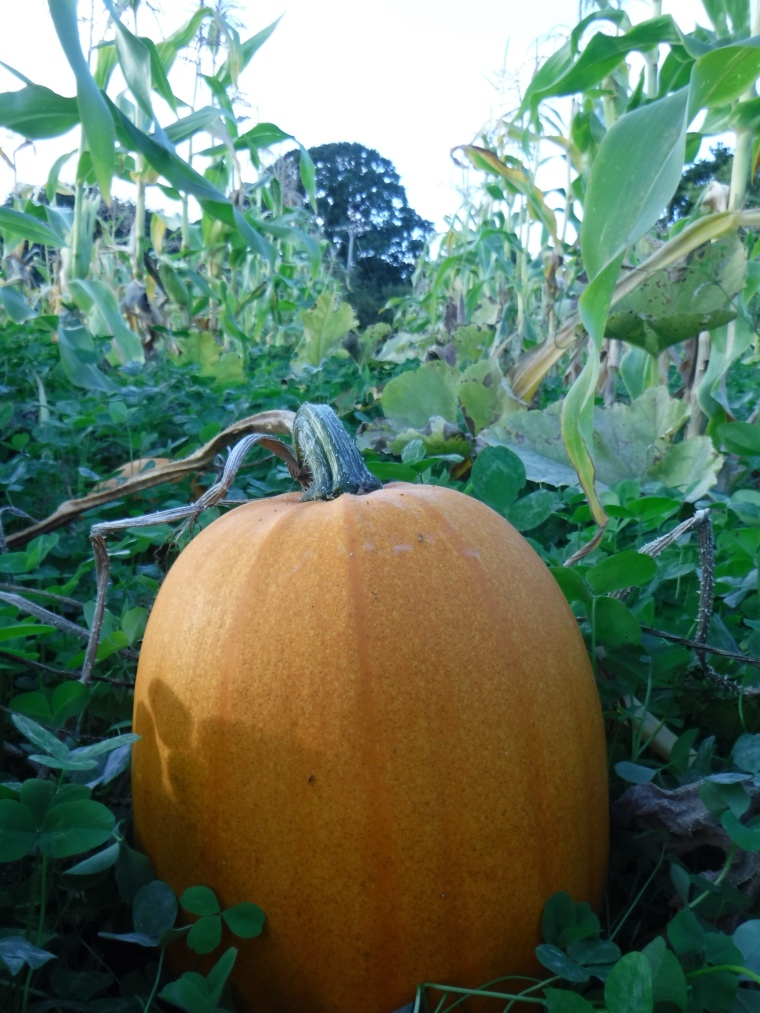
Our seventh season at Trill is coming to a close and we have had our best yet. The summer sun has kept the crops growing well and the rain seemed to come at just the right times. Since April we have harvested over two tonnes of salad and we seemed to get the timings of sowings just right this year, which has meant there has been no gap in salad production since February, and that should continue into December. Our new polytunnel has allowed us a little extra space to grow some of the salad leaves inside such as the sun loving summer purslane, as well as more basil which has done really well this year.
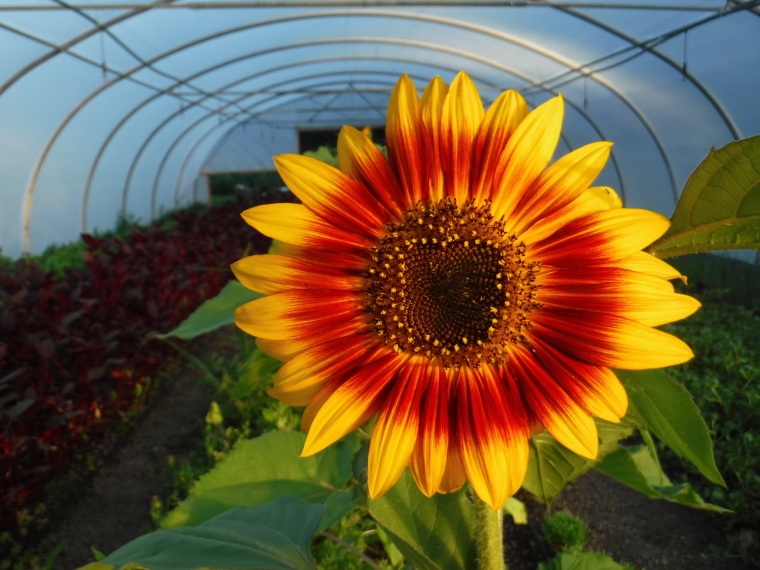
Now that Autumn is upon us it is time to start preparing the ground for next year. We will be sowing a mix of cereal rye and vetch on any bare ground, and covering some of the beds where early crops will go with black plastic, to minimise soil erosion and keep them relatively dry. One of the biggest jobs in October is the turnaround of the polytunnels. We will be pulling out all of the summer crops such as the tomatoes, french beans, cucumbers and peppers and making space for thousands of winter salad plants that were sown in module trays through September, as well as winter herbs, spring garlic, spring onions, peas and broad beans. This transformation usually takes place over a few days and as soon as the summer crops are put on the compost heap the tunnels are given a long soak with the overhead irrigation before given them a light dressing of compost and planting the winter crops often in the same day.
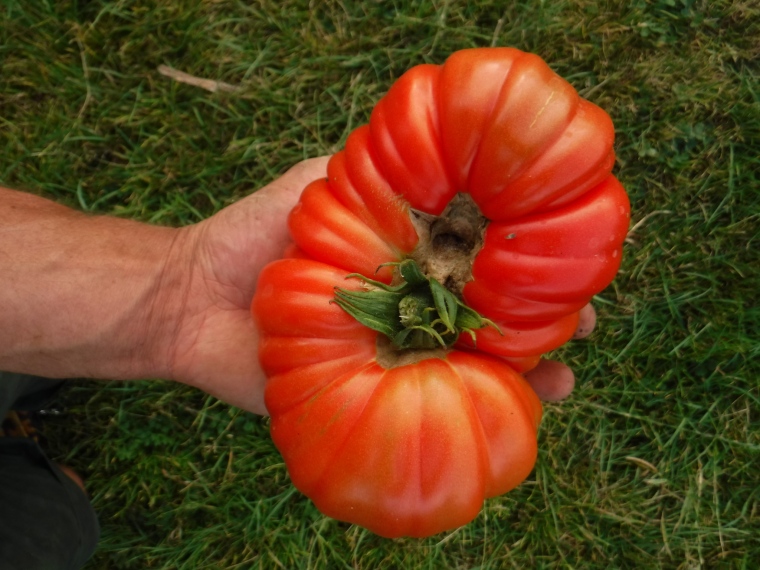
One of the joys of the end of summer and beginning of autumn for me is seed saving. We have been saving large quantities of salad leaf seed such as orache and salad burnet, as well as all of the tomatoes, some chillies, lots of beans, various herbs, beetroot, sunflowers and poppies. All in all we have saved over 20 varieties of vegetables, herbs and flowers for the next couple of years. The quantity of seed produced by plants never ceases to amaze me, and it is easy to save huge amounts of seed from a small patch of plants, some of which will last for a few years.
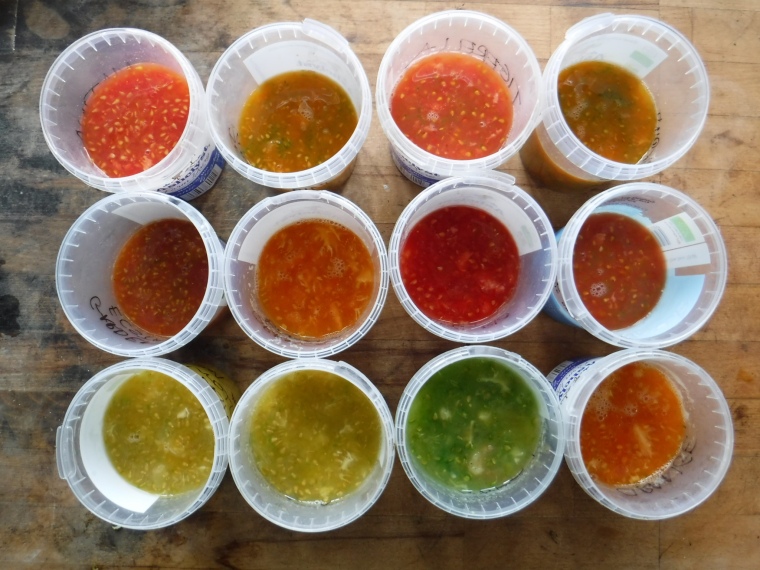
I will be running a course on seed saving next year, as well as one on market gardening. I am involved in setting up a new centre of land based skills called LandBase which aims to close the gap between the growing interest in land skills and the lack of structured learning facilities for new entrants to small scale food production in the UK.
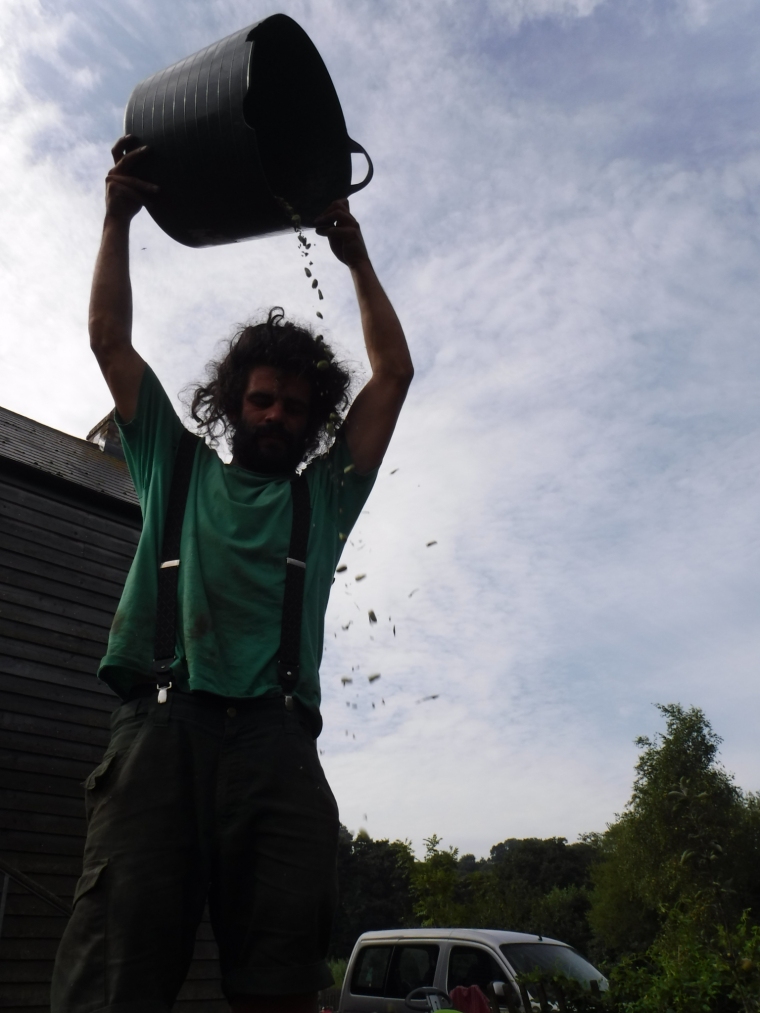
See more photos on Instagram @trillfarmgarden
Being organised before the summer onslaught
So much about growing good vegetables comes from being well organised. This I have learnt over the last six years of being at Trill, but also having been brought up on a market garden and seeing things gradually seem to get easier for my parents as their experience grew, but also as they became more organised and settled into their growing “systems”. We are still developing our systems, and perhaps this takes a life time, as you learn new things yearly. One such new thing that we have tried this year has come through borrowing a bedformer from a friend who is a grower near us. This has enabled us to create raised beds, and in doing so, taken the vegetables slightly further from the high water table here. In effect what the bedformer does is bring the soil from the paths (where the wheels of the tractor go) into the bed where the vegetables are planted, it then cultivates it to a fine tilth and rolls it to consolidate the tilth and break it down further. We aim to then only drive the tractor on these same paths or wheelings from now on, so compaction is limited to the paths and not where the vegetables grow. Perhaps we are finally getting some sort of system going.
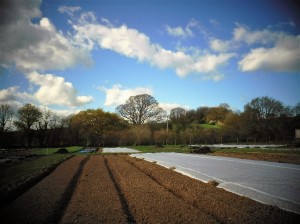
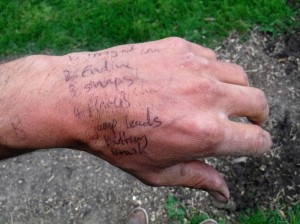
Being organised starts in the past, in that you must record things so that you can look back and see what you did, at what time you did it and whether it was successful. We have begun recording our sowing and planting dates more systematically now, and making comments by them if needs be, so that we can look back during the winter when we are planning for the next growing season. I have a large diary which comes out to the shed every day. 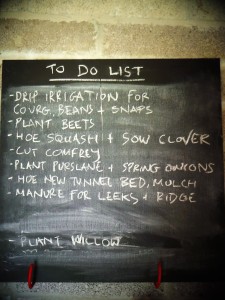 During the winter I write reminders in the next seasons diary so that I do not forget certain sowing times. I also consult the previous season’s diary and notes that I have made to remind me what sowing dates and planting times worked best. Doing this in the winter and being well prepared for the onslaught of summer has enabled us to get on with the summers work in a more enjoyable way, rather than the more frantic early years. That is not to say it does not get frantic for us at the height of summer, but certainly less frantic.
During the winter I write reminders in the next seasons diary so that I do not forget certain sowing times. I also consult the previous season’s diary and notes that I have made to remind me what sowing dates and planting times worked best. Doing this in the winter and being well prepared for the onslaught of summer has enabled us to get on with the summers work in a more enjoyable way, rather than the more frantic early years. That is not to say it does not get frantic for us at the height of summer, but certainly less frantic.
We put up yet another new (second hand, but new to us) polytunnel in late spring, at the damp end of the garden. It is already full of summer salads such as summer purslane that so loves the dry heat of a polytunnel, as does the basil that is in there. It will also enable us to grow just a few of the winter vegetables that just so hate the waterlogged soil outside the tunnels. But before talking too much about winter vegetables let us enjoy the summer produce!
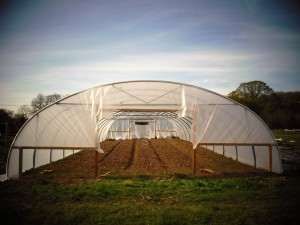
Tunnels, turnips and trainees
The polytunnels have been cleaned, the packing shed has had a revamp, the seeds are being sown and we wait for the ground outside to dry before we start cultivating and planting. We are prepared for the coming season.
This year, we are undertaking our first commercial seed growing, for the Real Seed Catalogue in Wales. They are a wonderful small seed company who produce and sell only open pollinated varieties of vegetables, herbs and flowers for gardeners and small scale growers. They provide information on each seed packet about saving seeds from that particular variety, encouraging gardeners to save and exchange their own seed. We will be growing chillies, sunflowers, poppies and a turnip called the Giant Limousin Turnip, which just happens to be from where by dad lives in France. The chillies will have to be grown in isolation from other varieties that we are growing – simply by growing them in a different polytunnel. The turnips will be sown in late summer/early autumn and then harvested before winter. We will then select the turnips which look most true to their variety and rogue out any diseased or unusual turnips that don’t show characteristics of the Giant Limousin turnip. The saved turnips will be stored overwinter in damp sand and then replanted in spring allowing them to flower and seed. We will collect the seed and process it, threshing and cleaning it and return it to the Real Seed Catalogue, as with all the other seeds that we will be saving, who will then offer it in their catalogue.
It has been a mild, wet winter, and yet again I am thankful for the polytunnels that we have, and the fact that we do not grow much winter veg. The tunnels build up algae on the plastic very quickly over the year, and the light levels inside them are heavily reduced. Usually we get by with using a combination of a pressure washer and a broom tied to a bean pole! I decided this year to treat myself to a window cleaners’ extendable water fed pole with a brush on the end to clean the outside of our polytunnels. It has worked a treat, and been much easier than the broom, beanpole and baler twine combination.
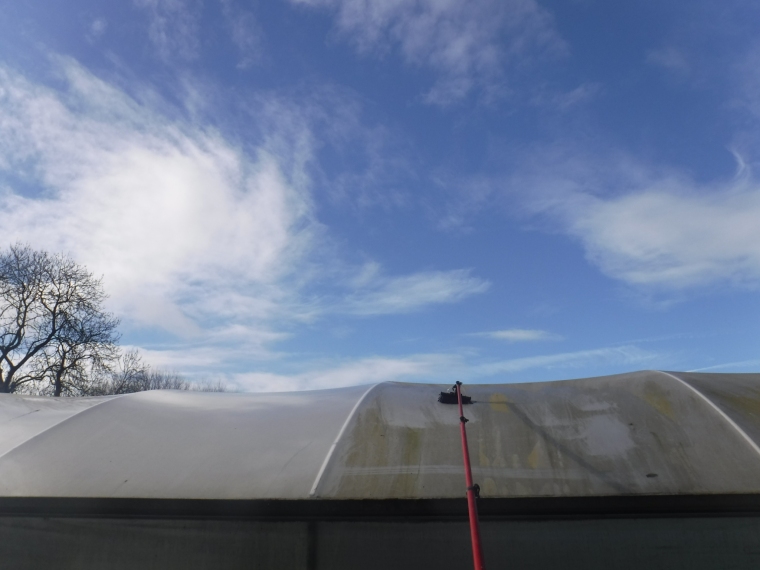
This year we welcome our third trainee – Ellen, who has been volunteering a day a week since August last year. To gain more practical knowledge, I took a student placement at Hestercombe Gardens when I was studying Horticulture. This placement was an invaluable experience – I learnt about dry stone walling, hedgelaying, chainsawing, historical garden design along with much more. The traineeship that we offer is similar in that it is very much about the trainee learning on the job and pushing their own development. Learning practically with a small scale business such as ours gives the trainee a chance to see how things actually work not only with the technical side of growing, but with how to make it ones livelihood. There seems to be a large number of people who have a hunger for learning about agroecological food production, and to be able to offer a short term traineeship feels a great way to share some of the knowledge that we have picked up over the last few years of being growers.
The traineeship is also a great way to share the model of how Trill Farm works, which I think addresses very well the issues of access to land. Many new entrants (such as ourselves) find that when they are ready to get going and starting a farming or growing business the main limiting factors are accessing affordable land and access to finance. At Trill, when we arrived the garden had already been setup and much of the infrastructure had been established, so we had to make very little investment. It would be great if established estates and landowners could open up their land to new agricultural and horticultural businesses and provide the resources required to support the demand by new entrants into farming and growing like Trill Farm has done for us.
Winter planning and muddy boots
Boots are now far heavier at the end of a day in the veg garden. Summer merged into autumn seamlessly, and although the weather was wetter, it remained very mild. So, November flew by with very few cold fingers but rather a lot of muddy boots and slippery paths. We picked far more salad throughout November than we usually do, due mainly to the unseasonably mild conditions. However, as we approach the shortest day of the year the leaves grow back very slowly after being cut, and with waterlogged soils outside most of the leaves other than chicory are now from the tunnels.
Winter harvests are now pretty much just down to Jerusalem artichokes which will be dug until about March time. These are such an easy crop to grow, and can be left in the soil all winter. We replant the tubers each spring, and ridge them only once, then leaving them until harvest starts in October. The last remaining crop to bring in before the weather gets too cold is the forcing chicory. Again, this is a relatively easy crop to grow, but is somewhat overlooked in the UK. We sow the seed into module trays in May, plant out the small plants by the end of June and then hoe once, before the leaves out crowd the weeds. The plants are then dug up in late autumn or early winter, the leaves are chopped off and the roots trimmed a little, leaving them in crates until they are required. To force the chicory we simply half fill deep crates with compost, deep enough to cover the roots and we plant the roots into the compost. Then the crates are put into a dark place (we usually stack them and cover with black plastic) and left for a few weeks. The chicory will use the energy stored in its roots to grow bullet shaped chicons (this usually takes about 10 weeks from planting in compost in February and keeping in the shed). The leaves are wonderfully sweet and crunchy and can be used in salads or braised.
This time of the year always lends itself to planning the garden for the next year, amending the cropping schedule and looking at how to change things to make life a little easier and to get the most out of the relatively small area that we grow on. With this in mind I have been thinking a lot about making some semi-permanent raised beds that will not be cultivated. They will be relatively dry compared to the cultivated part of the garden, as the beds will be slightly raised, and more organic matter will be added to them, which will improve the worm habitat, which in turn will aid drainage. We will also not be driving the tractor over the beds, so compaction will be reduced, and we will cover any empty beds with plastic over winter to keep drier. All of this will mean that we can use these beds for earlier crops, and they will also be used for more direct sown salad crops through the year. Because the land will not be cultivated, any weed seed will not be disturbed and brought to the surface, so over time the weed burden will be reduced and direct sown crops will not have to fight with the inevitable chickweed.
We were able to cover much of the soil this autumn either with a mix of cereal rye and vetch or with black plastic. The rye holds onto the nutrients in the soil, that would otherwise be leached and the vetch fixes nitrogen from the atmosphere into the soil. The plastic covers any bare soil and not only protects it from the elements, but also provides a great habitat for worms and voles which burrow about creating a great tilth by the time spring comes round. It is so important to protect the soil overwinter, and with more and more fields of maize grown (often for barn raised cows) around us, I see large areas of land with bare soil all winter, and worryingly vast amounts of topsoil being washed out of it during the winter downpours. This is bad farming practice in my eyes, we are caretakers of the land and so must try to build a healthier soil for our offspring, rather than deplete what we have.
The practice and politics of seed saving
It has been a mixed growing year. A dry June and early July, but with cool nights meant that many of the summer vegetables took some time to get going, and our tomatoes only got into full production at the very end of July and beginning of August. We had a lot of mildew on our courgette plants early on, which is caused by dry soil but high humidity, so they slowed down rapidly in July. There were blackfly like I have never seen before on our tunnel grown french beans, so much so that we had to pull them out in July. Then the dreary weather during August led to more mildew and slow growth. However, our salad has been very productive this year, and we have harvested about 1.75 tonnes from April to September, growing a wider variety of leaves than ever before.
We are also saving seed from a wider variety of crops than ever before including beans, tomatoes, beetroot, peas, various salad leaves, phacelia and many more. It is something that few growers practice, instead we habitually sit down in the autumn and go through the seed catalogues, picking out the old favourites and choosing some new or interesting varieties. The skill of seed saving has been all but lost, as the craft of being a grower or farmer is slowly being marginalised as farms become larger, more mechanised and less hands on. In much the same way as many of the traditional crafts have been industrialised, traditional methods of farming and growing have too. As these skills become rarer, people think of them as old fashioned, outdated and inefficient. To me it makes perfect sense to be saving seeds from the crops that grow the best on our soil, and in doing so we are selectively breeding crops that are suited to our location, soil and climate, rather than buying seed, much of which is grown in hotter, drier climates and is suited to very different conditions. Although it takes a bit of time to plan which plants to save seed from and time to harvest and process the seed, much of the time taken is when the growing season is slowing down, so it fits into our work patterns well. Something often overlooked about these traditional skills is the joy taken in practising them. I don’t think I have enjoyed any other horticultural task more than harvesting, threshing and winnowing seed. It is a similar feeling to preserving food for the winter months, as the seed is dried and packed away ready to be sown next year.
Another benefit of saving seed from many crops is that the plant is left to mature to a stage which is rarely seen, as they are left to flower and seed, when many would be cut down and cultivated in or pulled out before they get the chance to flower. Flowering plants of coriander and chervil attract huge numbers of parasitic wasps and other beneficial wasps that can help to keep pest numbers in check, whilst allium flower heads are covered by bees when they open. The diversity of insect life attracted to the flowers to pollinate them is quite remarkable and must not be overlooked as a benefit of saving seed.
Keeping this fundamental horticultural skill alive is one way that farmers and growers can take back control of the food system that has become industrialised and controlled by very few large companies. We must try to build a food system that is based on food sovereignty principles which puts control back in the hands of people, localises the food system, builds knowledge and skills and works with nature.
Slugs (again), soil (again) and slowing down
18th November 2014
For a vegetable grower autumn and winter is the time for slowing down and putting the garden to bed. On our heavy soil we tend not to grow too much winter veg, other than a few brassicas (which never seem to like it that much) and some parsnips as well as plenty of jerusalem artichokes. This means that there is not much to harvest through the winter, as the salad and other crops in the tunnels sit and wait for longer, warmer days.
I am never fussed about keeping the garden weed free over winter, in fact quite the opposite. I like to ensure that as much of the soil as possible is covered and protected over winter, and leaving weeds is one way of doing this. They hold the soil together, protecting its structure and minimising soil erosion caused by the heavy rains of winter. Any ground that is bare until about November tends to be sown with cereal rye and vetch (weather permitting – it has been too wet to get onto the ground and cultivate in preparation for sowing this autumn). This ensures that the nutrients in the soil are not lost through leaching, as rye has extensive roots which are great at holding onto nutrients and also bringing them up from deep in the soil. The vetch fixes some nitrogen from the atmosphere and so when the green manure is turned in during Spring, there is a steady release of nutrients for the preceding crops. If, like this year the soil is too wet to cultivate and prepare for sowing green manures in the autumn we tend to either leave a weed cover or cover it with straw to protect it and add organic matter, as well as providing a good habitat for worms, which aid drainage.
Looking after crops in the tunnels is very different, as they don’t get the continual winter rain that leads to leaching. We try to keep the tunnels weed free most of the time. This helps to remove slug habitats, which cause the most damage overwinter. We have had probably around 500 lettuce and chicory eaten by slugs in the tunnel this autumn, making me resort to collecting the dregs from a local brewery and enticing the slugs with award winning beer. Slugs are by far our main pest, especially in the tunnels and they are not especially easy to control organically. One method is “organic” slug pellets which are based on Ferric Phosphate (Iron). However, I am not totally comfortable using these, having seen reports suggesting that the chelating agent used in these pellets, called EDTA, is poisonous to other species and highly toxic to earthworms. I think I will stick to the beer.
Winter is a time in which I delve deeper into the politics of what we do as farmers and growers and put more time into working for The Landworkers’ Alliance. We have recently formed a seed saving cooperative amongst farmers and growers in the South West and will be hosting a session about seed sovereignty and seed networks at the excellent Oxford Real Farming Conference in January. It is great to get a wider picture of what we are doing and be able to step back from it in the winter to realise why we are doing it. We can then get back to it in the Spring re-fuelled with enthusiasm and energy.
Squash, soil and sleep
Autumn comes around as quick as Spring does. It is as much of a surprise to see the leaves turning on the trees as it is to see the first snowdrops. It is now the time that everything slows down, as days become shorter and the air cools, and although autumn is very much harvest time, the fruiting crops are beyond their pomp. We start eating more kale, squash and autumn salads, where chicory takes the main stage.
It is also the time of year that we must think about the following season, as some crops such as garlic and broad beans are planted in autumn, so the land must be ready for them. We will be covering some of the ground with plastic groundcover (which I have mixed feelings about) and much will be sown with cereal rye, seed of which we saved from this years crop. We left a small area to mature into the grain, and our volunteers hand cut and threshed it, giving us plenty of seed to resow this autumn. Cereal rye is a wonderful groundcover over winter, and is especially good mixed with vetch. The rye is a deep rooting plant that holds onto nutrients that would otherwise be leached away by the winter rains, and it binds the soil together so that erosion is minimised. The vetch is a leguminous plant so will also fix a little nitrogen before being incorporated into the soil in the spring. The plastic helps to protect the soil from the winter weather. We will be covering up areas that we hope to plant up early, so that all of the weeds are killed off and we can just rake the soil in the spring rather than having to cultivate it, which can be quite harmful to the soil structure if it is still wet. It is a struggle to cultivate the land early here as it is so poorly drained, so this should alleviate this problem, allowing us to crop slightly earlier than normal on this soil. We also have two new polytunnels this year which we will take advantage of by growing earlier crops of carrots, beetroot, spring onions and garlic.
Polytunnels will be emptied of tomatoes, peppers, cucumbers and beans and filled with small salad plants, winter herbs and early peas. These overwintering plants will slowly establish themselves, but not produce much until early spring when they will suddenly leap into action as day length increases significantly. Some of these plants such as chervil, parsley, mizuna and winter lettuce we saved seed from, so we will be sowing our own seed for next years crop. We have selected the healthiest looking plants, and in the case of salads and herbs, those that rose to seed the latest, to maximise leaf production.
Autumn is a relief from the hectic summer, and although there is still plenty to harvest and much planting to be done in the polytunnels, the pace of work slows and it is a good time to prepare for next year and look forward to a good winter break!
Slugs, mice, waterlogging…but things are looking up!
29th May 2014
It has been a long time since my last post. Much has happened. I will attempt to summarize the events chronologically.
One of our two new tunnels is skinned and up and running. We have begun planting chillies and peppers in it, and will probably just use it for bits of salad this summer. It was particularly heavy clay soil, but the land drains put in around it have helped to alleviate the problem of poor drainage (more of drainage a little later). There is also a plan to have a pop-up restaurant in their sometime in September.
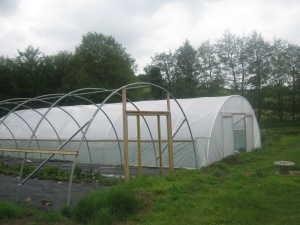
April saw the arrival of Winstanley Wheeler a fine young specimen. He was born on saturday the 5th April, and work continued on Monday – very thoughtful of him to come on the weekend. So, the last seven weeks have been a bit of a blur, what with it being one of the busiest times of year for the garden, but also having a new born. Thankfully we have taken on more labour this year, and we also have an apprentice helping us through the summer. We have therefore kept quite on top of things and most of the veg is looking good. There are a few exceptions, such as the 300 metres of carrots that were all grazed off by slugs, along with the 240 metres of peas that were all eaten by mice. Not to mention the struggling spring lettuce that was planted in a newly cultivated patch which turned out to have a spring in it. We did some soil tests and very low levels of available phosphorous were apparent. I think this is probably due to the ground being fairly saturated and the anaerobic conditions not favouring mycorrhizae and other microorganisms which help plants access nutrients. We have therefore dug a small pond to catch the spring water, and there is an overflow pipe which takes the water off the growing area. This definitely seems to be helping. We will be adding lots of organic matter to the soil once the lettuce have been harvested to try and improve the conditions for mycorrhizae and the like.
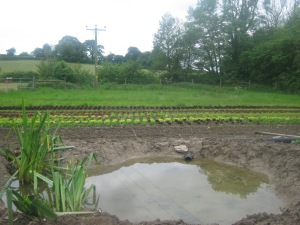
The spring has been pretty mild but also damp, which has meant huge numbers of slugs are about. Other than the carrots and turnips, they have not done too much damage yet, though there is more waste from the lettuce than usual. With extra help we are managing to keep on top of the weeds with lots of hoeing, and so minimising the slugs’ habitats around the plants. Probably the biggest change in the last month was the changeover from the winter salad to the french beans, tomatoes, cucumbers, basil and tomatillos in the large tunnel. All of these plants are now racing away as they have settled themselves into the soil. We will skin the next new tunnel once all of the summer crops have been planted outside in the next couple of weeks.
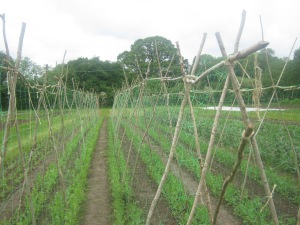
The garden is filling up, we are currently planting the courgettes and squash and beans will be next week – a little later than hoped, but I am sure they will catch up. Once again it is coming up to the time of the Green Scythe Fair (15th June) which is a great event celebrating haymaking with scythes. We will be at the fair selling lots of plants. We took lots of blackcurrant and chuckleberry cuttings this year, snd they all did very well, so we have far more than we need.
So, we have had a few setbacks this spring, but most of the vegetables are now growing away strongly. June will be a month of hoeing and weeding, as well as harvesting the first of the spring vegetables such as wet garlic, spring onions, beetroot, cucumbers and beans.

